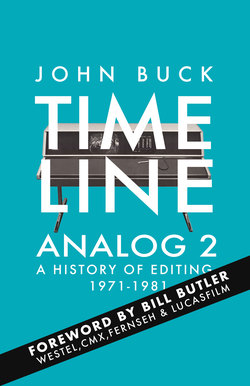Читать книгу Timeline Analog 2 - John Buck - Страница 12
На сайте Литреса книга снята с продажи.
PEC-102
ОглавлениеCentral Dynamics (CDL) progressed with its video editing device, the PEC-102. Ken Davies led the team.
We had finally mastered all of the software concepts on the PEC, like setting “in” and “Out” points on tape machines and the synchronizing of the Quad machines, the switcher control for dissolves and effects.
Fred Jackson, Kathy McConkey and Herb Radford handled the software development for the PEC-102 project. McConkey worked on edit list functionality and Radford on machine control.
There were difficult problems to be solved in the dynamics of cueing and synchronizing various manufacturers’ machines, with different motion characteristics and widely varying tape reel sizes. In cueing a machine to a cue point the only remote machine controls available were Fast Forward, Rewind and Stop.
To slow down a machine in high speed wind mode the controls were shuttled rapidly between Fast Forward and Rewind until the machine was slowed down to near stop and a Stop command could be issued with the expectation of having it stop within a few frames of the cue point.”
Unlike the CMX that used a PDP-11, the heart of the PEC-102 was a Data General Nova 1200 mini computer. Vesa Koponen recalls:
The PEC 102 was developed in the era of minicomputers with then current technology of standard TTL (Transistor-Transistor Logic). No microprocessors quite yet. One or more cards would be magnetic core memory cards, one tiny ferrite donut for each bit of memory. Total capacity of the card, 4-kilo words.
Ken Davies recalls that the Nova was cheaper and its developers had much in common with CDL.
Not only was the PDP-11 a little too complicated for what we needed and therefore more expensive that what we could afford, the support wasn’t that great for the environment that we expected the systems to live.
We picked the Data General Nova and over time we discovered that their team was very much like ours, a dedicated and wildly enthusiastic group pushing the limits of available technology in hardware and software.
It was a reasonably simple machine to program, its i/o was fast and the Nova was reliable. It definitely gave us the best bang for the buck but to this day I am amazed that we got the Nova to do all of the work we needed it to do.
With the decade barely started, editors would soon have two electronic systems to choose from. The CMX 600/200 and the PEC-102, had things in common but the differences between them was enormous.
CDL was inspired by its broadcast clients to create a conservative linear online editing system based on a timecode interface. Ken Davies explains:
Most of the source material for programs, 60 second spots and 4 minute packages, is close by on the tapes, whereas Adrian and CMX’s approach played to long form programs with rushes material all over the place. They had to have random access.
CMX was a computer company that had created a digital nonlinear system for broadcaster client. The interface was more scientific and futuristic. Davies adds:
On many occasions I have had to express the view that the cutting edge of TV production has always been very much ahead of the cutting edge of computers, especially in the days of the development of digital standards, when the computer folks looked down their noses at our work, carried out by a few dedicated pioneers, instead of the "suits" in the data processing industries and their suppliers.
